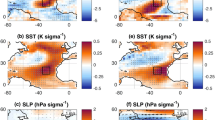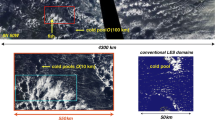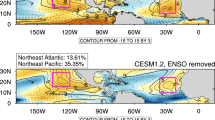Abstract
Over the tropical Atlantic during boreal spring, average interhemispheric differences in sea-surface temperature (SST) coincide with a coherent pattern of interannual climate variability often referred to as the Atlantic Meridional Mode. This includes anomalous SST and sea-level pressure roughly anti-symmetric about the equator, as well as cross-equatorial near-surface winds directed toward the warmer hemisphere. Within subtropical marine boundary layer cloud regions in both hemispheres, enhanced cloudiness associated with this variability is co-located with cool SST, a strong temperature inversion, and cold horizontal surface temperature advection, while reduced cloudiness is associated with the opposite meteorological conditions. This is indicative a positive cloud feedback that reinforces the underlying SST anomalies. The simulation of this feedback varies widely among models participating in phase 5 of the Coupled Model Intercomparison Project. Models that fail to simulate this feedback substantially underestimate the amplitudes of typical tropical Atlantic interhemispheric variability in cloudiness off of the equator, SST, and atmospheric circulation. Models that correctly reproduce a positive cloud feedback generally produce higher and more realistic amplitudes of variability, but with substantial scatter. Marine boundary layer clouds therefore appear to be a key element of springtime coupled atmosphere–ocean variability over the tropical Atlantic. A markedly more successful simulation of this variability in climate models may be obtained by better representing boundary layer cloud processes.




Similar content being viewed by others
References
Adebiyi AA, Zuidema P, Abel SJ (2015) The convolution of dynamics and moisture with the presence of shortwave absorbing aerosols over the southeast Atlantic. J Clim 28(5):1997–2024
Adler RF et al (2003) The version-2 Global Precipitation Climatology Project (GPCP) monthly precipitation analysis (1979–present). J Hydrometeorol 4(6):1147–1167
Amaya DJ, DeFlorio MJ, Miller AJ, Xie S-P (2016) WES feedback and the Atlantic Meridional Mode: observations and CMIP5 comparisons. Clim Dyn. doi:10.1007/s00382-016-3411-1
Bellomo K, Clement A, Mauritsen T, Rädel G, Stevens B (2014) Simulating the role of subtropical stratocumulus clouds in driving Pacific climate variability. J Clim 27(13):5119–5131
Bellomo K, Clement AC, Mauritsen T, Rädel G, Stevens B (2015) The influence of cloud feedbacks on equatorial Atlantic variability. J Clim 28(7):2725–2744
Bellomo K, Clement AC, Murphy LN, Polvani LM, Cane MA (2016) New observational evidence for a positive cloud feedback that amplifies the Atlantic Multidecadal Oscillation. Geophys Res Lett 43(18):9852–9859
Bony S, Dufresne J (2005) Marine boundary layer clouds at the heart of tropical cloud feedback uncertainties in climate models. Geophys Res Lett 32(20):L20,806
Bretherton CS (2015) Insights into low-latitude cloud feedbacks from high-resolution models. Phil Trans R Soc A 373(2054):20140,415
Brown PT, Lozier MS, Zhang R, Li W (2016) The necessity of cloud feedback for a basin-scale Atlantic Multidecadal Oscillation. Geophys Res Lett 43(8):3955–3963
Chang P, Ji L, Li H (1997) A decadal climate variation in the tropical Atlantic Ocean from thermodynamic air-sea interactions. Nature 385(6616):516–518
Chiang JC, Vimont DJ (2004) Analogous Pacific and Atlantic meridional modes of tropical atmosphere-ocean variability. J Climate 17(21):4143–4158
Clement AC, Burgman R, Norris JR (2009) Observational and model evidence for positive low-level cloud feedback. Science 325(5939):460–464
Cronin MF, Bond NA, Farrar JT et al (2013) Formation and erosion of the seasonal thermocline in the Kuroshio Extension Recirculation Gyre. Deep Sea Res Part II 85:62–74
Czaja A, Van der Vaart P, Marshall J (2002) A diagnostic study of the role of remote forcing in tropical Atlantic variability. J Clim 15(22):3280–3290
de Boyer Montégut C, Madec G, Fischer AS, Lazar A, Iudicone D (2004) Mixed layer depth over the global ocean: an examination of profile data and a profile-based climatology. J Geophys Res 109:C12
Dee D, Uppala S, Simmons A, Berrisford P, Poli P, Kobayashi S, Andrae U, Balmaseda M, Balsamo G, Bauer P et al (2011) The Era-Interim reanalysis: Configuration and performance of the data assimilation system. Q J R Meteorolog Soc 137(656):553–597
Evan AT, Foltz GR, Zhang D, Vimont DJ (2011) Influence of African dust on ocean-atmosphere variability in the tropical Atlantic. Nat Geosci 4(11):762–765
Evan AT, Allen RJ, Bennartz R, Vimont DJ (2013) The modification of sea surface temperature anomaly linear damping time scales by stratocumulus clouds. J Clim 26(11):3619–3630
Frankignoul C, Kestenare E (2005) Air–sea interactions in the tropical Atlantic: a view based on lagged rotated maximum covariance analysis. J Clim 18(18):3874–3890
Garay MJ, de Szoeke SP, Moroney CM (2008) Comparison of marine stratocumulus cloud top heights in the southeastern Pacific retrieved from satellites with coincident ship-based observations. J Geophys Res Atmos 113(D18)
Hartmann DL, Ockert-Bell ME, Michelsen ML (1992) The effect of cloud type on Earth’s energy balance: Global analysis. J Clim 5(11):1281–1304
Klein SA, Hartmann DL (1993) The seasonal cycle of low stratiform clouds. J Clim 6(8):1587–1606
Klein SA, Hartmann DL, Norris JR (1995) On the relationships among low-cloud structure, sea surface temperature, and atmospheric circulation in the summertime northeast Pacific. J Clim 8(5):1140–1155
Lacagnina C, Selten F, Siebesma AP (2014) Impact of changes in the formulation of cloud-related processes on model biases and climate feedbacks. J Adv Model Earth Syst 6(4):1224–1243
Lindzen RS, Nigam S (1987) On the role of sea surface temperature gradients in forcing low-level winds and convergence in the tropics. J Atmos Sci 44(17):2418–2436
Loeb NG, Wielicki BA, Doelling DR, Smith GL, Keyes DF, Kato S, Manalo-Smith N, Wong T (2009) Toward optimal closure of the Earth’s top-of-atmosphere radiation budget. J Clim 22(3):748–766
Myers TA, Norris JR (2013) Observational evidence that enhanced subsidence reduces subtropical marine boundary layer cloudiness. J Clim 26(19):7507–7524
Myers TA, Norris JR (2015) On the relationships between subtropical clouds and meteorology in observations and CMIP3 and CMIP5 models. J Clim 28(8):2945–2967
Myers TA, Mechoso CR, DeFlorio MJ (2017) Coupling between marine boundary layer clouds and summer-to-summer sea surface temperature variability over the North Atlantic and Pacific. Clim Dyn. doi:10.1007/s00382-017-3651-8
Nobre P, Shukla J (1996) Variations of sea surface temperature, wind stress, and rainfall over the tropical Atlantic and South America. J Clim 9(10):2464–2479
Norris JR, Evan AT (2015) Empirical removal of artifacts from the ISCCP and PATMOS-x satellite cloud records. J Atmos Ocean Technol 32(4):691–702
Norris JR, Iacobellis SF (2005) North Pacific cloud feedbacks inferred from synoptic-scale dynamic and thermodynamic relationships. J Clim 18(22):4862–4878
Qu X, Hall A, Klein SA, Caldwell PM (2014) On the spread of changes in marine low cloud cover in climate model simulations of the 21st century. Clim Dyn 42(9):2603–2626
Rossow WB, Schiffer RA (1999) Advances in understanding clouds from ISCCP. Bull Am Meteorol Soc 80(11):2261–2287
Sun M, Doelling DR, Raju RI, Nguyen LC, Loeb NG (2010) The CERES ISCCP-D2like cloud and radiative property data product. AGU Fall Meeting Abstracts
Tanimoto Y, Xie SP (2002) Inter-hemispheric decadal variations in SST, surface wind, heat flux and cloud cover over the Atlantic Ocean. J Meteorol Soc Jpn 80(5):1199–1219
Taylor KE, Stouffer RJ, Meehl GA (2012) An overview of CMIP5 and the experiment design. Bull Am Meteorol Soc 93(4):485–498
Wood R (2012) Stratocumulus clouds. Mon Weather Rev 140(8):2373–2423
Wood R, Bretherton CS (2006) On the relationship between stratiform low cloud cover and lower-tropospheric stability. J Clim 19(24):6425–6432
Xie S-P (1999) A dynamic ocean–atmosphere model of the tropical Atlantic decadal variability. J Clim 12(1):64–70
Xie S-P, Philander SGH (1994) A coupled ocean-atmosphere model of relevance to the ITCZ in the eastern Pacific. Tellus 46(4):340–350
Yuan T, Oreopoulos L, Zelinka M, Yu H, Norris JR, Chin M, Platnick S, Meyer K (2016) Positive low cloud and dust feedbacks amplify tropical North Alantic Multidecadal Oscillation. Geophys Res Lett 43(3):1349–1356
Zhang Y, Rossow WB, Lacis AA, Oinas V, Mishchenko MI (2004) Calculation of radiative fluxes from the surface to top of atmosphere based on ISCCP and other global data sets: Refinements of the radiative transfer model and the input data. J Geophys Res. 109(D19105)
Zuidema P et al (2016) Challenges and prospects for reducing coupled climate model SST biases in the eastern tropical Atlantic and Pacific oceans: The US CLIVAR Eastern Tropical Oceans Synthesis Working Group. Bull Am Meteorol Soc 97(12):2305–2328
Acknowledgements
This study was funded by NOAA’s Climate Program Office, Climate Variability and Predictability Program Award NA14OAR4310278. The research was partly carried out at the Jet Propulsion Laboratory, California Institute of Technology, under a contract with NASA. CERES data were obtained from the NASA Langley Research Center CERES ordering tool at http://ceres.larc.nasa.gov/. ISCCP data were downloaded from the Atmospheric Science Data Center located at NASA Langley Research Center. Joel Norris kindly provided the monthly-averaged corrected and uncorrected ISCCP data. ERA-Interim data were downloaded from the ECMWF data server at http://apps.ecmwf.int/datasets/. The authors thank both the World Climate Research Programme Working Group on Coupled Modeling, which is responsible for CMIP, and the climate modeling groups for producing and making available their model output. Thanks also to Paquita Zuidema and an anonymous reviewer for helpful comments that improved the manuscript.
Author information
Authors and Affiliations
Corresponding author
Electronic supplementary material
Below is the link to the electronic supplementary material.
Rights and permissions
About this article
Cite this article
Myers, T.A., Mechoso, C.R. & DeFlorio, M.J. Importance of positive cloud feedback for tropical Atlantic interhemispheric climate variability. Clim Dyn 51, 1707–1717 (2018). https://doi.org/10.1007/s00382-017-3978-1
Received:
Accepted:
Published:
Issue Date:
DOI: https://doi.org/10.1007/s00382-017-3978-1




